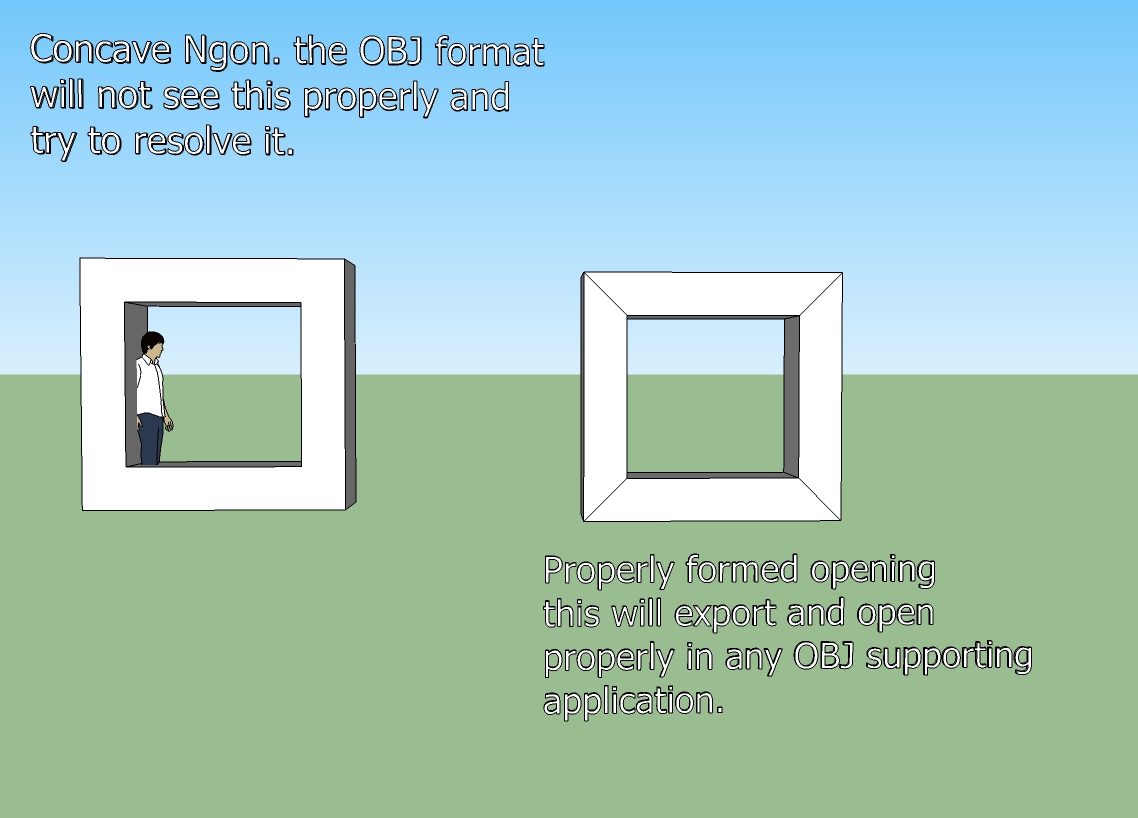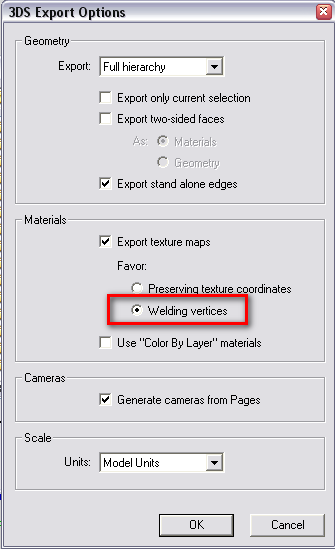A question about(smoothing +) exporting 4 use in Poser
-
ok you'll need to take some steps into account.
the easy fix is to get UVmapper (Uvmapper.com) and use that to "split vertices" that will stop the model ballooning. (Old School fix reliable but the model's them a mass of unconnected facets)
a better fix is to put a "micro bevel" in place - basically put an extra tiny face round the hard edges. (imagine the edge is | you put in extra edges to make ||| but as close as you can to the edge.)
also in poser, the properties for each mesh, you'll find "Crease Angle" and "Smoothing"
try turning Smoothing Off and adjusting the crease angle -0 = facets 100= smoothed out. I normally use 22.5 myself.
if you do the above, don't use 3ds. that's the worst format for poser. use OBJ (it's posers native format!) Tig's exporter works great... the OBJ's are being butchered because you need to adjust the model to poser's....quirks.
-
I haven't used Poser for a long time, but I seem to remember that OBJ from SketchUp worked best if you checked the "Triangulate all faces" option in the Export Options dialog box.
Anssi
-
Thank you for your fast response Khai! I did not expect on for for several days if any.
I've been told not to use the 3DS export option, but it is really the only one that works. When I say butchered, I really mean it. I have never had a model that was even remotely usable(made in SketchUp) that I was able to export in OBJ (to Poser). Parts are distorted, with odd spikes shooting off into infinity, windows and doors are closed or distorted and sometimes textures don't apply. I gave up on it a long time ago because I just never had a good result. I'll give TIG's exporter a try though, maybe that will work better. He really seems to make better free plugins than the SU programers make as paid upgrades.
You said "try turning Smoothing Off and adjusting the crease angle -0 = facets 100= smoothed out. I normally use 22.5 myself." Are you saying that to adjust the crease angle you have to turn off smoothing? Also the book I have says that most models should be 80-90° to not appear faceted, wouldn't 22.5° be faceted too?
Thanks again for your reply! -
@anssi said:
I haven't used Poser for a long time, but I seem to remember that OBJ from SketchUp worked best if you checked the "Triangulate all faces" option in the Export Options dialog box.
Anssi
Thanks( your response came up while I was posting my previous reply)... I have tried triangulate faces also but there seems to be little difference in the result. I'll try that with TIG's plugin,if that is an option though.
Thanks again. -
aah
you say you have holes closed? that's easy. you can't have concave faces in the OBJ format.gimme a bit to create a pic to show you.
-
ok here we go.
the problem is, the OBJ format does not support holes in a mesh unless you take some steps, namely defining the hole.on the left is a mesh that will error. see how the hole is not connected to the edge, forming an Ngon round the hole. that and similar, say the letter C etc will not work.
on the right, I've added 4 edges in the corners. this will work correctly. it's just a matter of resolving the shape. if you were using a C shape, you'd need to just join the inner curve to the outer to fix it. (hope that's clear, if not I'll draw a pic)

-
@unknownuser said:
"You said "try turning Smoothing Off and adjusting the crease angle -0 = facets 100= smoothed out. I normally use 22.5 myself." Are you saying that to adjust the crease angle you have to turn off smoothing? Also the book I have says that most models should be 80-90° to not appear faceted, wouldn't 22.5° be faceted too?
Thanks again for your reply!"I think that smoothing off on the mesh will fix most for you plus the modeling tricks, but I find 22.5 or 45 is the best balance for hard/curved like your model.
remember, 80 is the setting they use for humans in the software..
-
Thank you for that great explanation Khai! I have been told that OBJ can not handle holes in a mesh before, but you see plenty of OBJ models with what look like holes in them... Now I understand how it is possible!
The addition of the illustration really helped. -
Do you export your model as 3ds with vertices welded? Cjeck out the export options at the bottom right of the export window.

-
Sorry to reply so late, I just wanted to thank you folks for your help.
I manage to get the model to a usable state... I separated the glass(actually I deleted it and made a whole new part) and exported it as a separate model. They will be two separately loading PP2 files (I don't do PZ3, since DAZ Studio users can't load them). I chose the 3ds format again because in obj the model was importing into Poser in at two different scales and 3ds was not. I also went and found TIG's obj exporter and it is WAY better than SU's native one. I took Gaieus's advice for the glass section and chose "Favor: Welding vertices" for it, although I kept "Preserving texture coordinates" for the rest of the structure out of fear of having the textures get messed up (Poser 7 has a very awkward camera movement method that makes throughly checking a model VERY slow and painful).
I will take all this info I received here and experiment use it to experiment further to get the optimum results.
Once again thank you Khai, Anssi and Gaieus for all your help! -
@unknownuser said:
"I chose the 3ds format again because in obj the model was importing into Poser in at two different scales and 3ds was not."
ah
this one, when you import in poser, you'll have the choices "Percent of standard figure size 100%" and "centered"turn those OFF. ok, the model will import at a huge scale,(poser scale is tiny. a legacy thing), but it will then import at the correct scale with each other and in the correct position to each other.
then in poser, open the Hierarchy Window, and drag the pieces together to form a single unit (eg, for your model above, drag "Dome" so it becomes a child of "Walls").
then select the parent and rescale that. the child parts will rescale as well.
Advertisement







